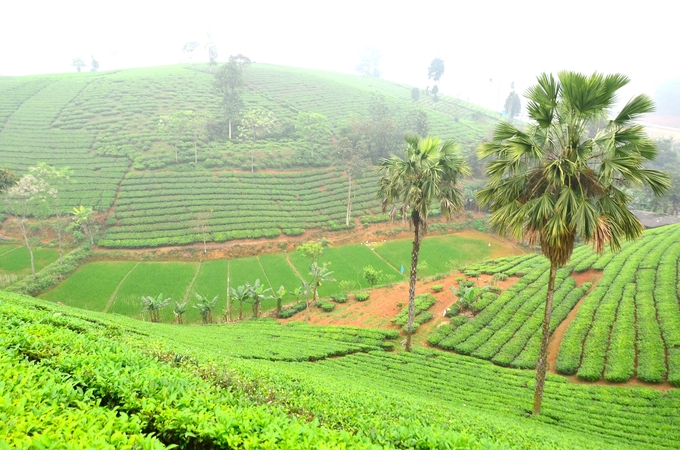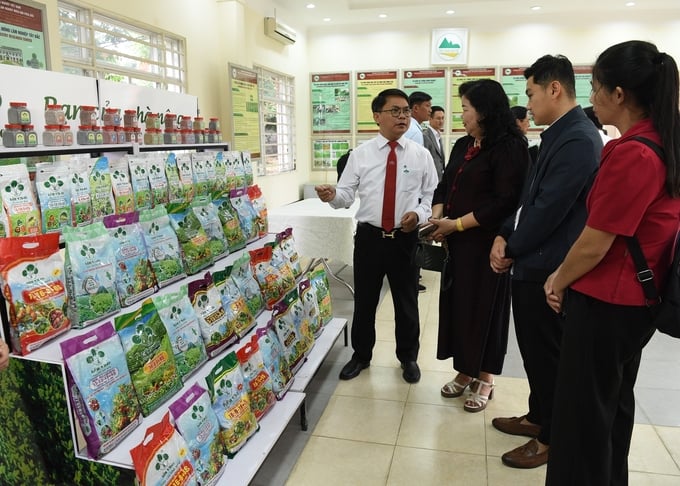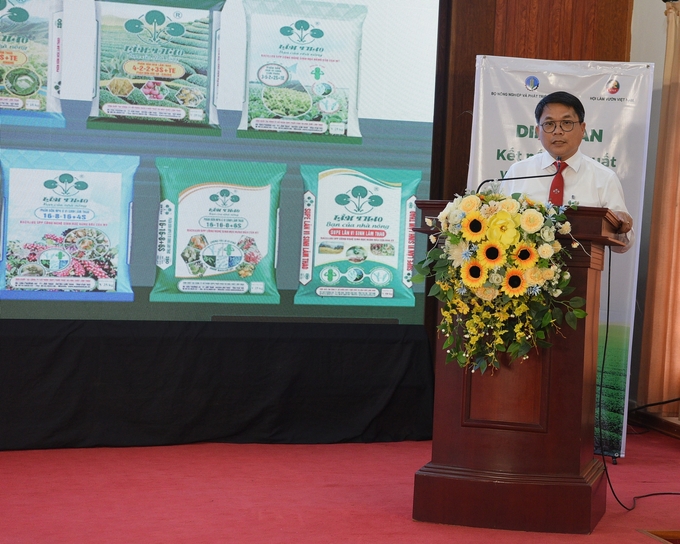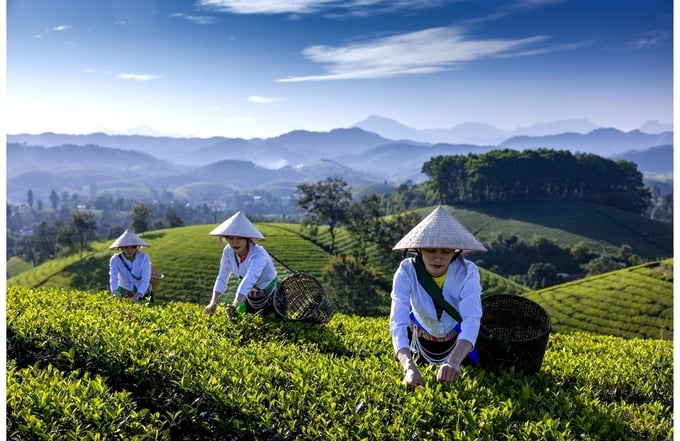May 20, 2025 | 13:42 GMT +7
May 20, 2025 | 13:42 GMT +7
Hotline: 0913.378.918
May 20, 2025 | 13:42 GMT +7
Hotline: 0913.378.918

Long Coc tea hill, Phu Tho. Photo: Duong Dinh Tuong.
Under the direction of the Ministry of Agriculture and Rural Development (MARD), The Department of Crop Production, the Vietnam Gardening Association, the Vietnam Agriculture Newspaper, and the Northern Mountainous Region Institute of Agricultural and Forestry Science (NOMAFSI) jointly organized the Forum on Connecting the production and consumption of high-quality tea on the morning of November 5.
The forum gathered more than 100 delegates in person, including representatives from agencies and research institutes under MARD, businesses, associations, and northern mountainous provinces, along with 30 journalists covering the event. Thousands of delegates participated and followed the forum through the electronic platforms and social media of the Vietnam Agriculture Newspaper.
According to Mr. Nguyen Quoc An, Deputy General Director of Supe Phosphates and Chemicals Lam Thao Joint Stock Company (Lam Thao Fertilizer), with the current development of the socio-economic landscape, the demand for safe food and agricultural products is increasing. Clean, safe agricultural production is a sustainable development trend that brings many economic, environmental, and social benefits. It is also a way to adapt to climate change and an inevitable trend for participating in the global value chain.
Not standing apart from this growing trend, Supe Phosphate and Chemical Lam Thao Joint Stock Company has proactively embraced a bold transformation in recent years. The company has shifted towards the production and introduction of new-generation fertilizers designed to meet the demands of clean agriculture and organic farming. It has also become one of the pioneering enterprises in providing green farming solutions for a wide range of crops, including tea.
To meet the market demand for fertilizers suitable for green and sustainable agricultural practices, Supe Lam Thao has developed a comprehensive set of organic-mineral fertilizers, consisting of four distinct products. In addition to these, the company has also advanced the formulation of new fertilizers that are based on traditional products, incorporating beneficial microorganisms to create innovative bio-fertilizers.
Among these new offerings are the Supe Phosphate Bio-fertilizer, the NPK Bio-fertilizer, and the Organic-Mineral Bio-fertilizer, all branded under Lam Thao. This product line have the slogan “Lam Thao Fertilizers - Reducing emissions and adapting to climate change - Enhancing soil health". The distinguishing feature of these fertilizers lies in the unique combination of inorganic fertilizers, organic fertilizers, and beneficial Bacillus microorganisms. These microorganisms are developed using cutting-edge, proprietary technology from Biowish, USA.
These microorganisms have the ability to antagonize various fungi and pathogenic microorganisms, enhancing the plant's resistance to pests and diseases. They help reduce the use of chemical pesticides, increase the plant's tolerance to adverse conditions such as acidity (aluminum toxicity), salinity, and organic poisoning, by supporting soil pH balance.

Mr. Nguyen Quoc An, Deputy General Director of Supe Phosphate and Chemical Lam Thao Joint Stock Company, introduced the company’s green trend fertilizer products. Photo: Duong Dinh Tuong.
These microorganisms play a key role in transforming complex, hard-to-degrade organic matter into simpler, more easily accessible organic compounds. They also convert phosphorus and other difficult-to-digest nutrients in the soil into forms that plants can readily absorb. In addition, they stimulate root development, making it easier for plants to take up nutrients, thus promoting healthier growth. This process not only helps plants thrive but also leads to a reduction in the amount of synthetic fertilizers needed.
The Bacillus microorganisms further contribute by supporting the growth of beneficial organisms and microbes already present in the soil. This helps improve the overall structure of the soil, increasing its porosity, humus content, and fertility. One of the key benefits of using fertilizers containing these beneficial microorganisms is the significant reduction in the need for chemical fertilizers and pesticides. This not only leads to the production of cleaner, safer agricultural products but also helps minimize the release of greenhouse gases, contributing to the fight against climate change and improving the health of the soil.
As part of the "Lam Thao Fertilizers – Reducing emissions and adapting to climate change - Enhancing soil health" product line, the Lam Thao Organic-Mineral Bio-fertilizer 3-5-2+2S+TE is specifically formulated from a blend of organic-mineral fertilizers and carefully selected Bacillus microorganism strains.
This product not only delivers a well-balanced supply of macronutrients, micronutrients, and various strains of beneficial microorganisms, but it also contains carbon and organic acids, such as humic acid and fulvic acid. These organic acids play a crucial role in stimulating the development of plant roots, encouraging stronger and healthier root systems.
The abundant organic content helps improve the soil structure by making it more loose and porous, promoting strong root growth while minimizing water loss due to evaporation. This also helps combat drought and soil erosion. These benefits have a significant impact on the soil structure, improving its physical, chemical, and biological properties, increasing its fertility, and counteracting the trend of desertification.
Research conducted by the Fertilizer and Plant Nutrition Research Center, part of the Institute of Soil Science and Fertilization, has shown that the use of the "Lam Thao Fertilizers – Reducing emissions and adapting to climate change - Enhancing soil health" product line has brought tangible benefits to farmers. These benefits include a reduction in fertilizer usage by 10-20%, helping farmers save on input costs, as well as a 15-20% increase in crop yields.

Mr. Nguyen Quoc An, Deputy General Director of Supe Phosphate and Chemical Lam Thao Joint Stock Company, gave a speech at the tea forum. Photo: Duong Dinh Tuong.
For tea crops specifically, Supe Lam Thao has developed an effective fertilizer demonstration model and is currently implementing the solution "Lam Thao Fertilizers – Reducing emissions and adapting to climate change - Enhancing soil health" in Thai Nguyen. This involves the use of Lam Thao NPK-S*M1 Bio-fertilizer 12-5-10+14S and Lam Thao Organic-Mineral Bio-fertilizer 3-5-2+2S+TE.
The amount of fertilizer used in this model is reduced by 10-13% compared to conventional fertilizers. At present, the tea plants using this solution are growing well, strong, and healthy, with fast-growing and robust buds. The tea products harvested are of high quality and meet clean standards.
Continuing its goal to enhance the effectiveness and value of its fertilizers, Supe Lam Thao has recently introduced a new line of fertilizers containing 100% potassium sulfate (K₂SO₄) as the primary nutrient source. This type of fertilizer is notable for its high potassium content - up to 50% - along with 18% sulfur. It is particularly beneficial for crops that have a high demand for sulfur.
The use of this potassium sulfate-based fertilizer has a range of benefits for crops. It encourages earlier flowering and faster ripening. It also enhances the sweetness and flavor of fruits, improves their color, and helps to increase overall crop yield. In addition, it plays a crucial role in strengthening the plants, helping to prevent them from toppling over (lodging) and reducing the incidence of empty grains in crops like rice.
The fertilizer also supports the growth of larger tubers and helps leafy vegetables maintain their vibrant green color for longer periods, improving their shelf life and quality during transportation. The fertilizer’s ability to enhance the plants’ resilience extends to cold tolerance and pest resistance. A key advantage of this fertilizer is that it is chlorine-free, making it especially suitable for crops that are sensitive to chlorine, such as tea, tobacco, coffee, and aromatic plants.

Tea harvesting in Long Coc. Photo: Tony Luan.
With the goal of providing the best products to support green agriculture, Supe Lam Thao is continuing its research to introduce "Green farming solutions – Rnhancing soil health – Reducing greenhouse gas emissions, adapting to climate change". These solutions will offer farming practices for tea crops specifically, as well as for other crops in general, based on the following criteria:
First, to meet the growing demand for clean agricultural products among consumers. Second, to use farming methods that minimize the use of pesticides, helping to limit negative environmental impacts. Third, to increase farmers' income by saving on fertilizer and pesticide costs; improved product quality will lead to higher market value, enhancing economic efficiency. Fourth, to contribute to the long-term sustainability of agricultural activities, ensuring a balance between agricultural development and the conservation of natural ecosystems.
Through this tea forum, Supe Phosphate and Chemical Lam Thao Joint Stock Company hopes to continue receiving support from government agencies, media organizations, and especially farmers, so that cooperation between all parties can grow stronger and more sustainable.
Translated by Phuong Linh

(VAN) Khanh Hoa is investing over 545 billion VND to develop 240 hectares of high-tech marine aquaculture in order to guarantee a consistent supply of seafood exports and achieve the USD 1 billion target.

(VAN) Minister of Agriculture and Environment Do Duc Duy held a meeting with Soopakij Chearavanont, Chairman of C.P. Group, on May 15.
/2025/05/16/3800-0-nongnghiep-143756.jpg)
(VAN) Suntory PepsiCo Vietnam coordinated with the Ministry of Education and Training to implement an education program on water conservation, reaching nearly 1 million primary school students nationwide.

(VAN) Vietnam’s TH Group officially put its high-tech fresh milk processing plant into operation in the Russian Federation, marking a historic moment as the first TH true MILK cartons were produced in Russia.

(VAN) Use of high-quality broodstock and biotechnology is regarded as the most effective approach to ensuring sustainable and economically viable shrimp aquaculture ahead of climate change and the emergence of increasingly intricate disease patterns.

(VAN) Carbon farming is a form of agricultural practices that helps absorb more greenhouse gases than it emits, through smart management of soil, crops, and livestock.

(VAN) This is a key content of the Memorandum of Understanding recently signed between the Vietnam Fisheries Society and Kunihiro Inc of Japan.